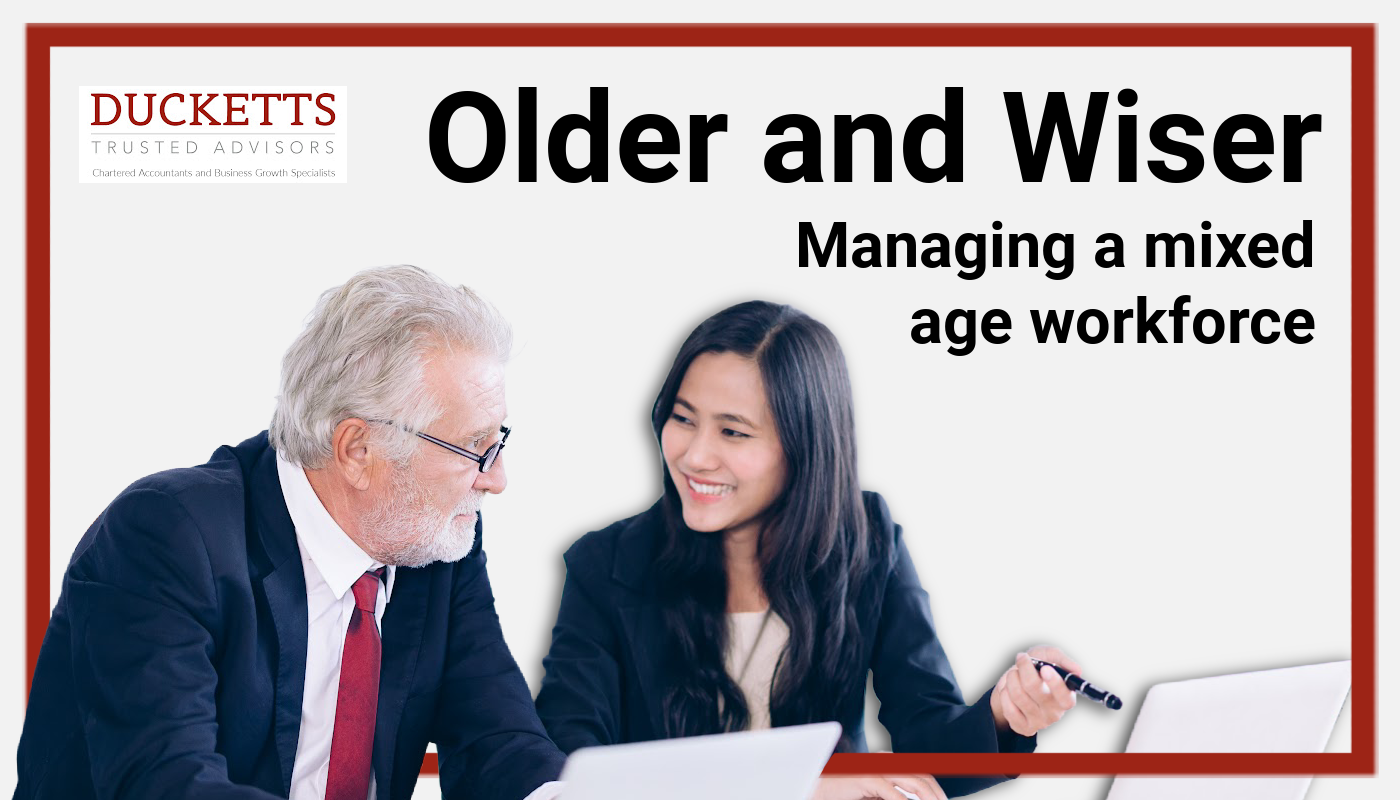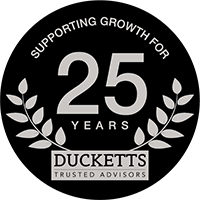Older and Wiser - Managing a mixed age workforce.
Published:

Many businesses are likely to have some ‘ageing’ in their workforce. This is probably only going to increase as improved health later in life could justify delaying retirement age across many economies. So how do we harness the skill sets of both younger and older employees?
The dilemma – older employees want to stay for longer, younger employees want to progress, the two ‘age groups’ have very different skills, expectations and interests. Working together may lead to clashes and tension (not here I hasten to add!).
The key is to actively manage the issues whereas most businesses are not even thinking about it.
Now, we wouldn’t be making specific reference to anyone at Ducketts (certainly not about the 3 oldies in the Business Development Team) but the below article by Steve Butler - Chief Executive at Punter Southall Aspire, covers how an ageing workforce can be useful to gain a competitive edge and how to avoid conflict when integrating the older generation.
Watching my children and their friends think about starting their careers has been a real eye-opener. Even though they're in their early 20s, they aren't really thinking about starting careers at all - many are doing a second degree, even if they're not particularly academic. Their reasoning seems to be "Why not?”. Others are planning to travel, or to spend a couple of years working in a pub before they get the job that they really want.
I don't mean to sound like an old fuddy-duddy, but it just wasn't like that in my day. Everyone I knew finished their degrees and immediately started submitting CVs to prospective employers.
This is just one sign of a profound change that's happening in the workplace. It is a change that, as an employer, is very much on my mind. And it's one that I believe all of us should be talking about much more. You see, as we live longer, people's work patterns are shifting. My children's generation know that they might very well live into their 80s, 90s or even past 100. They might be working, in some form or another, until they are octogenarians. So, what's the rush to get started? There isn't any.
As a CEO, I look at them and wonder whether in a few years' time we're going to have trouble recruiting good young people, and what the other implications will be for our workforces when people start work later in life.
In some industries there already appears to be a hiring crunch. Anecdotal evidence seems to suggest, for example, that a huge proportion of financial advisers are in their 50s or older, with a shortage of young people joining the profession. Of course, industry-specific reasons may contribute to this, but I see it as part of a wider trend. Meanwhile, at the other end of the spectrum, people are already working much longer than they used to. Retirement ages are inching upwards, and many people never really retire at all. The bottom line is that as we begin to live longer, our workforce will age too.
As an employer that throws up both challenges and many opportunities. As my own company has grown and we have hired or brought many more employees under our umbrella, I've come to realise that these issues are not theoretical. They're real, and they're happening now.
How can your older workers transmit the knowledge they have gained over decades to younger colleagues, and in turn encourage them to share their knowledge with older generations?
THE TIME IS NOW Some of the most talented leaders in our company were frustrated. In their late 30s and 40s they felt they had earned a seat at the top table. They were right and they were ready for it. But there were just eight spots on our executive committee, most of which were occupied by equally talented and capable leaders who were a generation older than them. It didn't seem fair that they would have to wait for someone to retire in order for one of those spots to become available. So, I disbanded the executive committee, replacing it with seven operational committees for different areas of the business. That way, we were able to quickly involve more people in our leadership structure as well as creating a more diverse, multi-generational team at the top.
As the UK workforce ages, you are likely to encounter this kind of dilemma more often. Your older employees may want to stay on board for longer, well past what was traditionally considered retirement age. Staff in that age group may have very different skills, expectations and interests to your millennial workers, and even those in their 40s. Working together may lead to clashes and tension - and not just over leadership positions.
What benefits should you provide? What kinds of working hours are appropriate? What pace of work? What technological skills should be expected? Balancing everyone's needs can be challenging.
There are also opportunities to consider. You'll need to find ways to help everyone work together in a productive way - and gain the full benefit of a multi-generational workforce. For example, how can you help your older workers transmit the knowledge and experience they have gained over decades to their younger colleagues, and in turn encourage younger colleagues to share their own unique knowledge with older generations? There are no easy answers, but - as my experience with the executive committee shows - the key is to actively manage the issues around an ageing workforce.
The reality is that most companies today barely think about these issues. They might officially be committed to age diversity, and perhaps have official policies around age discrimination, but in many cases these formal rules often amount to an insurance against litigation and do not translate into meaningful practices within the organisation. Research suggests that companies that do promote the employment of older workers often limit their recruitment to customer-facing or low-skilled jobs, and that discrimination continues to be widespread. Engagement with the issues around the ageing workforce is often extremely superficial.
Even if you have equal opportunity rules in place, has anyone thought about training for your older workers? Or how to help your managers work with employees in very different age brackets? Has anyone considered how to build on the strengths of older workers? If the answer to these questions is no, it is neither surprising nor unusual. For many companies this is still a relatively new area.
So how can you start preparing your company for an ageing workforce? Start by rolling age into the initiatives you run in any case around diversity. Help your employees understand that there are enormous benefits to working in a multi-generational environment, just as working in a multicultural environment helps everyone. Remember that everyone has knowledge to share - older generations retain a lot of institutional and operational knowledge that would otherwise be lost. You should also think about creating cross-generational mentoring programmes to share that knowledge.
Zero tolerance towards ageism should be a given, just as zero tolerance of sexism and discrimination against minorities is now the norm. You can achieve this by showing the generations working together that they're all dependent on each other's success. Encouraging staff to work together in age-diverse projects helps them develop trust, enabling them to work together towards a common goal. Team-based incentive and reward systems work particularly well.
Make sure you acknowledge inter-generational tension when it happens, and deal with it. Do not allow conflict to bubble under the surface and fester, because it will affect your work environment. And if it seems likely that you will experience an increase in older workers and a decline in younger workers, develop good policy sooner rather than later.
At a minimum, employers should strive to be intolerant of ageism, offer flexible working conditions, consider workers who have also become family carers and permit phased retirement. But there may be many other sensible policies to help your workforce.
Don't wait until problems arise. Be proactive about planning, so everybody wins, including your staff and your company. .
Adapted from an original article by Steve Butler, Published September 2020 in “Business & Management”
Latest Posts
The Budget 2025
Welcome to the Team, Adam Wright!
Volatile, Uncertain, Complex and Ambiguous.
Meet The Team - Phil Taylor
Tax Tips 2025

